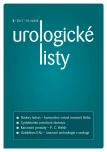Continent and incontinent urinary diversion, bladder sparing approaches
Authors:
A. Čermák; D. Pacík; V. Vít
Published in:
Urol List 2012; 10(3): 34-43
Overview
Bladder cancer represents the second most common malignant disease in Europe. The invasive and locally advanced bladder cancers are both urological malignant diseases associated with high mortality rate. The standard surgical treatment for most patients with infiltrating bladder cancer without any marks of generalization includes radical cystectomy. Since radical cystectomy is an extensive surgery (mortality in European studies around 3.7%, early post-operative morbidity 30%) there is a tendency to replace it by less effective but also less demanding therapeutic modalities in elderly patients and patients in whom surgery represents a significant risk. The collective urinary tract has three functions: the one of transportation, storage and evacuation. The individual segments of urinary collective tract are morphologically and functionally inter-related. In case one of the segments is absent (urinary bladder in case of cystectomy, which ensures both storage and evacuation), its function has to be replaced artificially. This substitutive method is called urinary diversion. Ideally the substitution of bladder enables to secure both of its functions – storage and evacuation – in less ideal cases at least replacing the emptying function. Specific segments of gastrointestinal tract are used for urinary diversion. There are several techniques for urinary diversion available. The choice of technique in individual patients is based on objective parameters and surgeon’s preferences. The major objective of any approach is the preservation of physiologic renal function and smooth urinary evacuation if possible. Each choice should be considered individually, based on the objective parameters, including size, localization and biological potential of the tumour, anatomic factors, the overall patient status and comorbidities. The subjective factors include the individual centre and surgeon experience. Of great importance is also detailed and comprehensible discussion with the patient, who must be informed about the individual options, their risks and benefits.
Key words:
bladder cancer, radical cystectomy, urinary diversion, ureteroileostomy, sigma-rectum pouch, heterotopic bladder substitute, orthotopic bladder substitute
Sources
1. Jarolím L. Derivace moči po cystektomii. Urol List 2008; 6(2): 53–59
2. Simon J. Ectopia vesicae (absence of the anterior walls of the bladder and pubis abdominal parieties); operation for directing the orifices of the ureters into the rectum; temporary success; subsequent death; autopsy. Lancet 1852; 2: 568–570.
3. Maydl K. Prvé případy radikálního léčení rozštěpeného měchýře. Čas Lék Čes 1894; 33: 337–343.
4. Maydl K. Neue beobechtungen von ureterenimplantaionen in die flexura romana bei ectopia vesicae. Wien med Wschr 1896; 46: 1241, 1333, 1373.
5. Pawlík K. Exstirpace močového měchýře. Čas Lék Čes 1890; 29: 705–706.
6. Hradec E. Chirurgische behandlung der strahlenschäden an der weiblichen harnblase. Urol Int 1962; 14: 89–110.
7. Jarolím L, Babjuk M, Hanuš T et al. Ortotopická náhrada močového měchýře u ženy po cystektomii se zachováním funkční uretry. Rozhl Chir 1996; 75(4): 222–226.
8. Jarolím L, Babjuk M, Hanuš T et al. 20 orthotopic neobladders in females. Eur Urol 1996; 30: 264.
9. Jarolím L, Babjuk M, Hanuš T et al. Female urethra sparing cystectomy and orthotopic bladder replacement. Eur Urol 1997; 31(2): 173–177.
10. Kučera F, Záťura F. Urologie jako samostatný vědní obor. Čes Urol 1998; 1: 34–35.
11. Bricker EM. Bladder substitution after pelvic evisceration. Surg Clin N Am 1950; 30(5): 1511–1521.
12. Thüroff JW, Alken P, Riedmiller H et al. 100 cases of Mainz-pouch (mixed augmentation ileum "n zecum for bladder augmentation and continent urinary diversion. World J Urol 1985; 11(3): 179–184.
13. Jarolím L. Kontinentní ileocékální měchýř (Mainz pouch). Rozhl Chir 1988; 67(10): 625–632.
14. Hautmann RE. The ileal neobladder to the female urethra. Urol Clin North Am 1997; 24(4): 827–835.
15. Jarolím L. Le Ducova implantace ureterů do neoveziky. Rozhl Chir 1989; 68(11): 714–717.
16. Skinner DG, Boyd SD, Lieskovsky G et al. Lower urinary tract reconstruction following cystectomy: experience and results in 126 patients using the Kock ileal reservoir with bilateral ureteroileal urethrostomy. J Urol 1991; 146(3): 756–760.
17. Studer UE, Danuser H, Merz VW et al. Experience in 100 patients with an ileal low pressure bladder substitute combined with an afferent tubular isoperistaltic segment. J Urol 1995; 154(1): 49–56.
18. Smith E, Yoon J, Theodorescu D. Evaluation of urinary continence and voiding function: early results in men with neo-urethral modification of the Hautmann orthotopic neobladder. J Urol 2001; 166(4): 1346–1349.
19. Zachoval R, Záleský M, Vik V et al. Sexuální funkce šetřící radikální cystektomie. Urol List 2008; 6(2): 36–47.
20. Colombo R, Bertini R, Salonia A et al. Overall clini- cal outcomes after nerve and seminal sparing radical cystectomy for the treatment of organ confined blad- der cancer. J Urol 2004; 171(5): 1819–1822.
21. Hohenfellner R. Ureterosigmoidostomy. Revisite Akt Urol 1990; 21: 63–66.
22. Fisch M, Hohenfellner R. Der sigma-rektum pouch: eine modifikation der harnleiterdarmimplantation. Akutelle Urol 1991; 22: 1–9.
23. Fisch M, Wammack R, Mueller SC et al. The MAINZ pouch II (Sigma rectum pouch). J Urol 1993; 149(2): 258–263.
24. Jarolím L, Babjuk M, Hanuš T et al. Kontinentní močová derivace s použitím detubulizovaného rektosigmatu (sigma-rectum pouch) Čas Lék Čes 1996; 135: 664-667.
25. Jarolím L, Babjuk M, Hanuš T et al. One layer suture in Mainz pouch II – 50 cases. Eur Urol 1996; 30: 755.
26. Zachoval R, Urban M, Záleský M et al. Double J stent versus nefrostomie při drenáži horních močových cest. Urol List 2004; 2: 43–46.
Labels
Paediatric urologist UrologyArticle was published in
Urological Journal

2012 Issue 3
Most read in this issue
- Rare complicaton of insertion double J stent – migration to right heart atrium
- Continent and incontinent urinary diversion, bladder sparing approaches
- Current view on small renal masses
- Robot assisted radical cystectomy: the Mayo Clinic technique
